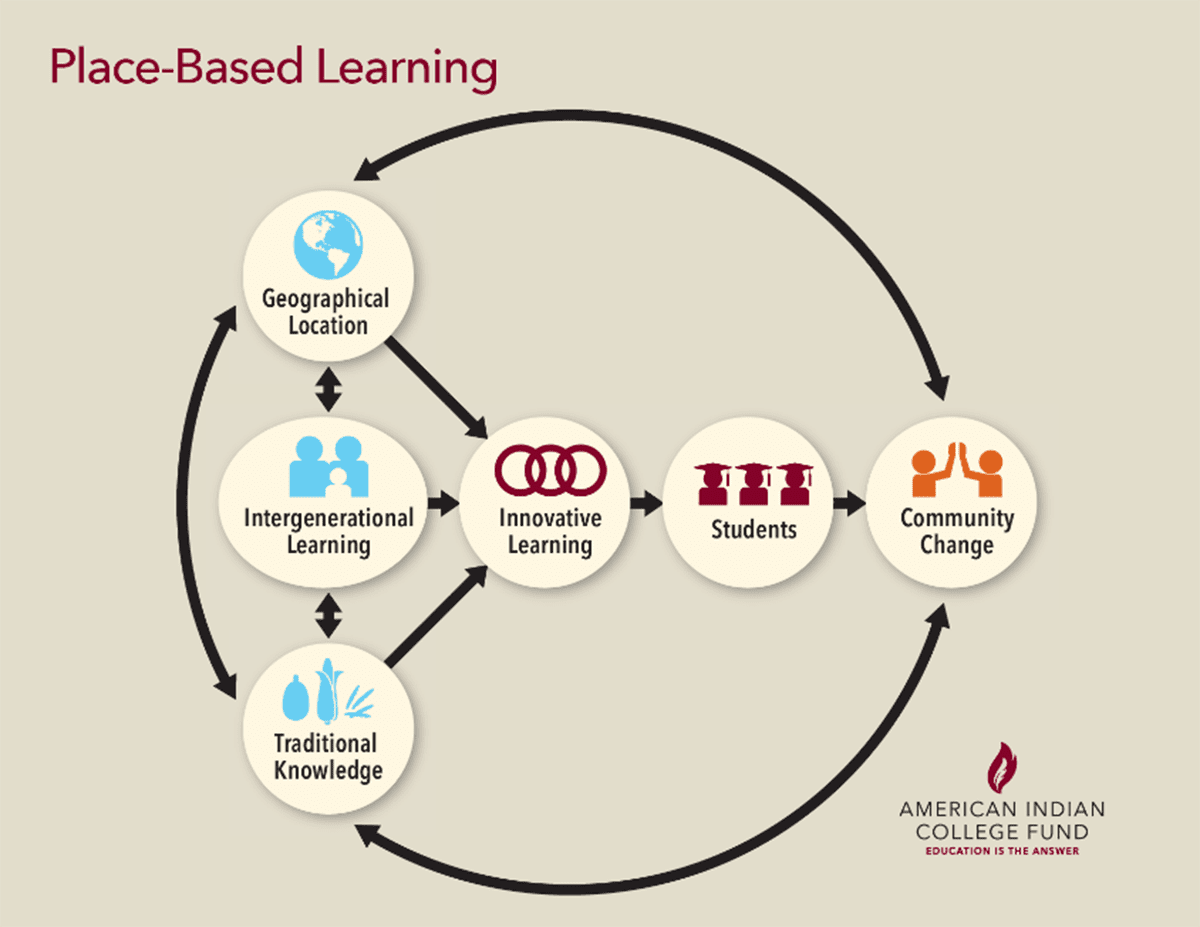This is a collaborative series developed by the College Fund’s Environmental Sustainability, Native Arts and Early Childhood Education program initiatives. This is the first blog of a six-part series focused on place-based education.
The American Indian College Fund (the College Fund) serves 35 Tribal Colleges and Universities (TCU) across the United States. The College Fund offers a variety of programs that support Native arts, early childhood education and environmental sustainability. Each of these initiatives are beneficial to the institutions they serve by promoting TCUs abilities to provide place-based, culturally embedded curriculum and programming, which provide students education that reflects and is responsive to their community’s needs.
TCUs have the distinctive ability to re-envision education and create innovative curriculum that engages academics and cultural knowledge to provide well-rounded opportunities for the students attending. Place-based education honors traditions and knowledge that exists within Native communities.
This graphic serves as a working model to support understandings of place-based learning that occurs at Tribal Colleges and Universities.
Place-based knowledge also promotes the opportunity for students and faculty to establish relationships between learning outcomes with enacting change in their communities. TCUs utilize cultural bearers and speakers of Native language who are rooted in their history and traditions to help teach and pass on their knowledge to students and community members.
“You will see a group of engaged children learning to love their culture and be proud of who they are. These children will be actively learning new things while enjoying the traditions of their ancestors. You will see children connecting with their community, elders, peers, and ancestors through stories, books, and songs. You will see elders and community members coming in to our class to share with us their gifts of knowledge. You will see children bringing their own drumsticks so they can drum with their friends; they feel safe here. You will see boys with long hair; you will hear them talk about why they wear it that way and what it means to them.” (2017 Restorative Teachings KBOCC Annual Report, page 20).
In addition, tribal communities’ long-standing relationships with geographical locations allow TCUs to draw on knowledge associated with the surrounding landscapes and to host academic courses and community extension workshops.
“The root of our culture is in the ground. The roots of our cultures as Indigenous people are the roots of the plants. They create our environment and they create our culture. The plants that are growing around us, the soil types, All of that starts in the earth….How you weave your baskets, what foods you eat, what hunting style (you have), what planting style…—Are you an agroecologist? Are you a hunter-gatherer? -all these different things that are put on us in terms of a culture, are based on where we are from…The sustainability of our culture and the sustainability of our environment are wrapped into one.”
-Sage La Pena (Nomtipom Wintu)
The incorporation of traditional cultural practices is central for TCUs because they are creating systems of Indigenous knowledge that reach far beyond the classroom. Native students foster change in their communities by building upon the indigenized learning and skills they have gained. TCUs are positioned to provide place-based, culturally responsive educational programs that support the lifetime of learning.
We invite you to share how you use place-based education in your areas of work and additional resources in the comments section.
This blog is the first in a monthly series about place-based education. Follow us here and read the following blogs in the series:
- Traditional Native Arts
- Environmental Sustainability
- Early Childhood Education
- Dynamic interaction of Traditional Native Arts, Environmental Sustainability, and Early Childhood Education
- The Benefits of Place-Based Education
Access these additional resources on place-based education:
• Padeken Ah Nee-Benham, M.K. & Cooper, J.E. (2000). Indigenous Educational Models for Contemporary Practice: In our Mothers Voice (Vols. 1-2). Mahwah, NJ: Lawrence Erlbaum Associates, Inc. Publishers.
• McCarty, T.L., (2002). A Place to be Navajo: Rough Rock and the Struggle for Self-Determination in Indigenous Schooling. Mawhah, NJ: Lawrence Erlbaum Associates, Inc. Publishers.
• UpS Featured in Latest HerbalGram. (n.d.). Retrieved from https://www.unitedplantsavers.org/ .
• Deloria, V.D. Jr. and Wildcat, D. (2001). Power in Place: Indian Education in America. Golden, CO: Fulcrum Publishing.
• Kimmerer, R., (2003) Gathering Moss: A Natural and Cultural History of Mosses. Corvallis, OR: Oregon State University Press.
Find out more about The College Funds research and program initiatives.

